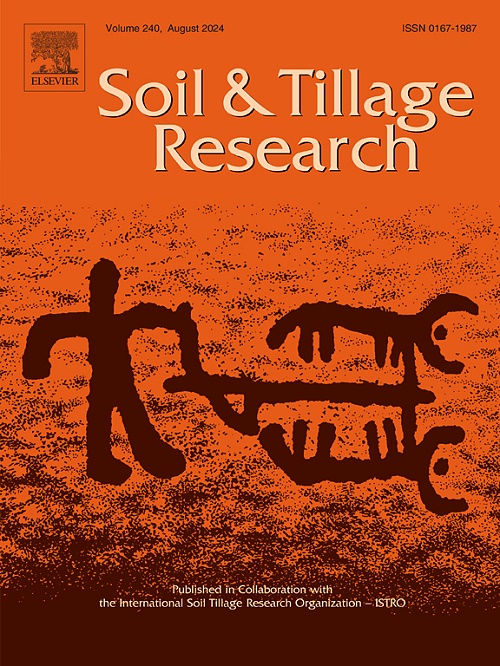三峡库区紫色土抗集中流侵蚀的EICP减缓效果及机理
IF 6.8
1区 农林科学
Q1 SOIL SCIENCE
引用次数: 0
摘要
集中流引起的土壤侵蚀严重影响土壤的可持续发展。酶促碳酸盐降水(EICP)是一种有效的土壤加固方法,但其对土壤侵蚀的缓解效果和机制尚不清楚。因此,以三峡库区紫色土(TGRA)为研究材料,采用4种不同浓度(0.5、1.0、1.5和2.0 mol·L−1)的EICP溶液和未处理土壤对照(CK)。在6个不同的维持时间(1、7、15、30、60和120 d)中,评估了表观黏聚力(AC)、骨料稳定性(MWD和GMD)和碳酸钙含量(CaCO3)的变化。测定了6种不同剪应力(4.07、6.05、8.04、10.12、12.08和14.04 Pa)下的土壤剥离能力(Dc),估算了土壤抗侵蚀能力(细沟可蚀性Kr和临界剪应力τc),并分析了影响因素。此外,还分析了EICP影响土壤抗侵蚀能力的微观机制。结果表明,EICP显著提高了AC、MWD、GMD和CaCO3,显著降低了Dc。与对照相比,EICP处理的Kr降低了24.74 ~ 77.91 %,τc增加了29.73 ~ 171.20 %,其中在1.5 mol·L−1处理时效果最为显著。此外,EICP处理前7 d内Kr和τc的变化分别占总变化的75.44 ~ 91.28 %和43.29 ~ 89.05 %。此外,Kr和τc与AC、MWD、GMD和CaCO3呈显著负相关和显著正相关。此外,EICP通过直接影响AC、MWD、GMD和CaCO3间接影响Kr和τc。此外,在EICP处理下,CaCO3以球形晶体形式附着在样品表面。这些结果表明,EICP显著提高了紫色土壤的抗侵蚀能力,可以作为一种快速、生态友好的方法来控制TGRA的土壤侵蚀,确保土壤的可持续发展。本文章由计算机程序翻译,如有差异,请以英文原文为准。
Mitigation performance and mechanism of the EICP for the erosion resistance of purple soil to concentrated flow in the Three Gorges Reservoir area
Concentrated flow induced soil erosion seriously influences sustainable soil development. Enzyme-induced carbonate precipitation (EICP) is a useful approach for soil reinforcement, but its mitigation performance and mechanism on soil erosion remain unclear. Therefore, using purple soil in the Three Gorges Reservoir area (TGRA) as the research material, EICP solutions at 4 different concentrations (0.5, 1.0, 1.5, and 2.0 mol·L−1) and an untreated soil control (CK) were employed. Variations in apparent cohesion (AC), aggregate stability (MWD and GMD) and calcium carbonate content (CaCO3) were evaluated over 6 different maintenance durations (1, 7, 15, 30, 60, and 120 d). The soil detachment capacity (Dc) was recorded under 6 different shear stresses (4.07, 6.05, 8.04, 10.12, 12.08, and 14.04 Pa), soil erosion resistance (rill erodibility Kr and critical shear stress τc) was estimated, and the influencing factors were revealed. Moreover, the micromechanism of EICP affects soil erosion resistance was elucidated. The results showed that EICP significantly increased AC, MWD, GMD and CaCO3 but significantly decreased Dc. Compared to CK, Kr decreased by 24.74∼77.91 % whereas τc increased by 29.73∼171.20 % in the EICP treatments, with the most pronounced effect occurring at 1.5 mol·L−1. Moreover, the variations in Kr and τc under EICP treatments within initial 7 d accounted for 75.44∼91.28 % and 43.29∼89.05 %, respectively, of total variations. In addition, Kr and τc had significantly negative and positive relationships with AC, MWD, GMD and CaCO3. Moreover, EICP indirectly influenced Kr and τc by directly affecting AC, MWD, GMD and CaCO3. Furthermore, CaCO3 was attached to the surface of the samples in a spherical crystal form under EICP treatment. These results clarify that EICP significantly increased the erosion resistance of purple soil and can serve as a rapid, eco-friendly approach for controlling soil erosion and ensuring sustainable soil development in the TGRA.
求助全文
通过发布文献求助,成功后即可免费获取论文全文。
去求助
来源期刊

Soil & Tillage Research
农林科学-土壤科学
CiteScore
13.00
自引率
6.20%
发文量
266
审稿时长
5 months
期刊介绍:
Soil & Tillage Research examines the physical, chemical and biological changes in the soil caused by tillage and field traffic. Manuscripts will be considered on aspects of soil science, physics, technology, mechanization and applied engineering for a sustainable balance among productivity, environmental quality and profitability. The following are examples of suitable topics within the scope of the journal of Soil and Tillage Research:
The agricultural and biosystems engineering associated with tillage (including no-tillage, reduced-tillage and direct drilling), irrigation and drainage, crops and crop rotations, fertilization, rehabilitation of mine spoils and processes used to modify soils. Soil change effects on establishment and yield of crops, growth of plants and roots, structure and erosion of soil, cycling of carbon and nutrients, greenhouse gas emissions, leaching, runoff and other processes that affect environmental quality. Characterization or modeling of tillage and field traffic responses, soil, climate, or topographic effects, soil deformation processes, tillage tools, traction devices, energy requirements, economics, surface and subsurface water quality effects, tillage effects on weed, pest and disease control, and their interactions.
 求助内容:
求助内容: 应助结果提醒方式:
应助结果提醒方式:


